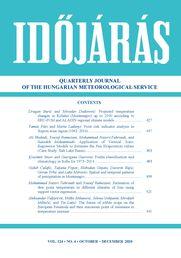Időjárás - Quarterly Journal of the Hungarian Meteorological Service (OMSZ)
Vol. 124, No. 4 * Pages 427–560 * October - December 2020
 |
|
 download [pdf: 2798 KB]
download [pdf: 2798 KB]
Foehn classification and climatology in Sofia for 1975–2014
Krasimir Stoev and Guergana Guerova
DOI:10.28974/idojaras.2020.4.4 (pp. 483–497)
Krasimir Stoev and Guergana Guerova
DOI:10.28974/idojaras.2020.4.4 (pp. 483–497)
IDŐJÁRÁS - Quarterly Journal

Az IDŐJÁRÁS a HungaroMet Nonprofit Zrt. negyedévenként megjelenő angol nyelvű folyóirata
Megrendelhető a journal.idojaras@met.hu címen.
A szerzőknek szánt útmutató itt olvasható.
Megrendelhető a journal.idojaras@met.hu címen.
A szerzőknek szánt útmutató itt olvasható.









